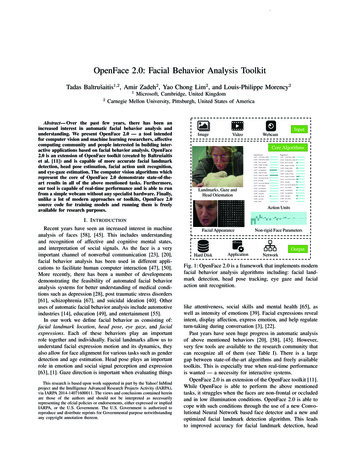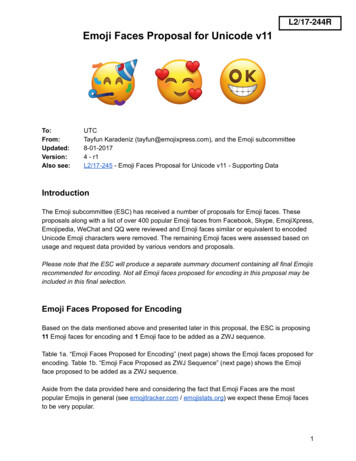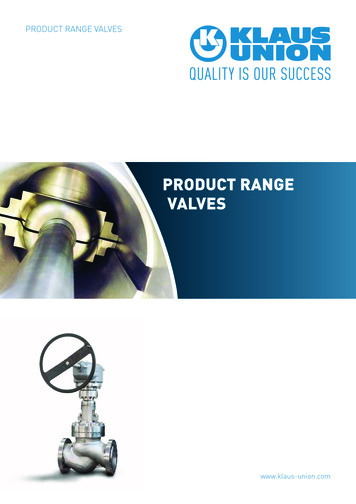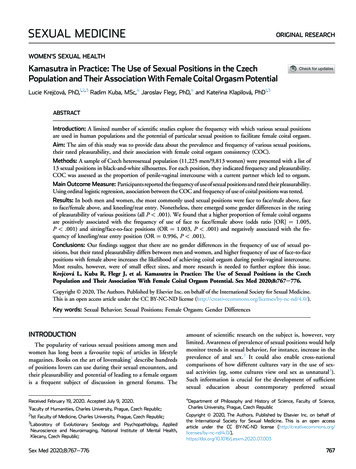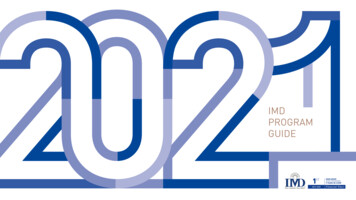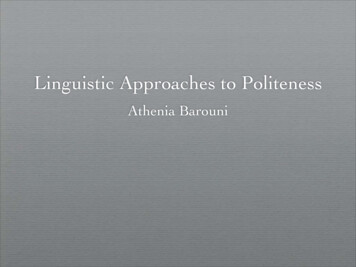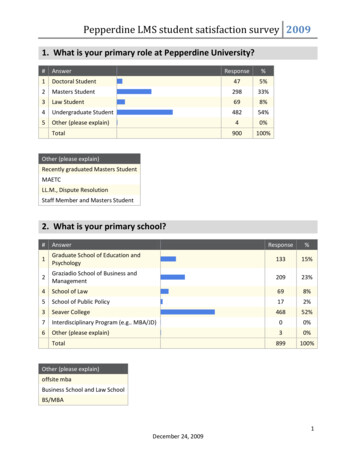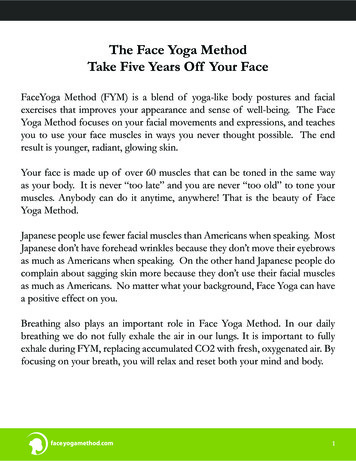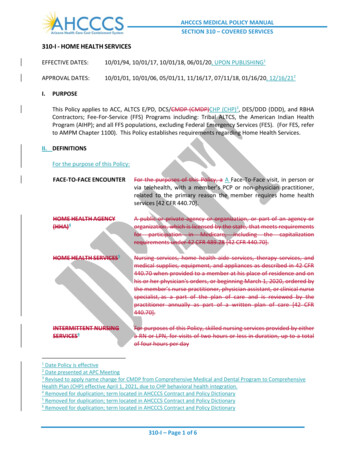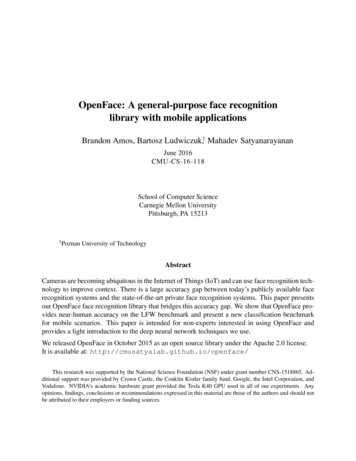
Transcription
OpenFace: A general-purpose face recognitionlibrary with mobile applicationsBrandon Amos, Bartosz Ludwiczuk,† Mahadev SatyanarayananJune 2016CMU-CS-16-118School of Computer ScienceCarnegie Mellon UniversityPittsburgh, PA 15213† PoznanUniversity of TechnologyAbstractCameras are becoming ubiquitous in the Internet of Things (IoT) and can use face recognition technology to improve context. There is a large accuracy gap between today’s publicly available facerecognition systems and the state-of-the-art private face recognition systems. This paper presentsour OpenFace face recognition library that bridges this accuracy gap. We show that OpenFace provides near-human accuracy on the LFW benchmark and present a new classification benchmarkfor mobile scenarios. This paper is intended for non-experts interested in using OpenFace andprovides a light introduction to the deep neural network techniques we use.We released OpenFace in October 2015 as an open source library under the Apache 2.0 license.It is available at: http://cmusatyalab.github.io/openface/This research was supported by the National Science Foundation (NSF) under grant number CNS-1518865. Additional support was provided by Crown Castle, the Conklin Kistler family fund, Google, the Intel Corporation, andVodafone. NVIDIA’s academic hardware grant provided the Tesla K40 GPU used in all of our experiments. Anyopinions, findings, conclusions or recommendations expressed in this material are those of the authors and should notbe attributed to their employers or funding sources.
Keywords: face recognition, deep learning, machine learning, computer vision, neural networks, mobile computing
1IntroductionVideo cameras are extremely cheap and easily integrated into today’s mobile and static devicessuch as surveillance cameras, auto dashcams, police body cameras, laptops, smartphones, GoPro,and Google Glass. Video cameras can be used to improve context in mobile scenarios. The identityof a person is a large part of context in humans and modulates what people say and how they act.Likewise, recognizing people is a primitive operation in mobile computing that adds context toapplications such as cognitive assistance, social events, speaker annotation in meetings, and personof interest identification from wearable devices.State-of-the-art face recognition is dominated by industry- and government-scale datasets. Example applications in this space include person of interest identification from mounted camerasand tagging a user’s friends in pictures. Training is often an offline, batch operation and producesa model that can predict in hundreds of milliseconds. The time to train new classification modelsin these scenarios isn’t a major focus because the set of people to classify doesn’t change often.Mobile scenarios span a different problem space where a mobile user may have a device performing real-time face recognition. The context of the mobile user and people around them provide information about who they are likely to see. If the user attends a meetup, the system shouldquickly learn to recognize the other attendees. Many people in the system are transient and theuser only needs to recognize them for a short period of time. The time to train new classificationmodels now becomes important as the user’s context changes and people are added and removedfrom the system.Towards exploring transient and mobile face recognition, we have created OpenFace as ageneral-purpose library for face recognition. Our experiments show that OpenFace offers higheraccuracy than prior open source projects and is well-suited for mobile scenarios. This paper discusses OpenFace’s design, implementation, and evaluation and presents empirical results relevantto transient mobile applications.22.1Background and Related WorkFace RecognitionFace recognition has been an active research topic since the 1970’s [Kan73]. Given an inputimage with multiple faces, face recognition systems typically first run face detection to isolate thefaces. Each face is preprocessed and then a low-dimensional representation (or embedding) isobtained. A low-dimensional representation is important for efficient classification. Challenges inface recognition arise because the face is not a rigid object and images can be taken from manydifferent viewpoints of the face. Face representations need to be resilient to intrapersonal imagevariations such as age, expressions, and styling while distinguishing between interpersonal imagevariations between different people [Jeb95].Jafri and Arabnia [JA09] provide a comprehensive survey of face recognition techniques upto 2009. To summarize the regimes, face recognition research can be characterized into featurebased and holistic approaches. The earliest work in face recognition was feature-based and sought1
Figure 1: Training flow for a feed-forward neural network.to explicitly define a low-dimensional face representation based on ratios of distances, areas, andangles [Kan73]. An explicitly defined face representation is desirable for an intuitive feature spaceand technique. However, in practice, explicitly defined representations are not accurate. Laterwork sought to use holistic approaches stemming from statistics and Artificial Intelligence (AI)that learn from and perform well on a dataset of face images. Statistical techniques such as Principal Component Analysis (PCA) [Hot33] represent faces as a combination of eigenvectors [SK87].Eigenfaces [TP91] and fisherfaces [BHK97] are landmark techniques in PCA-based face recognition. Lawrence et al. [LGTB97] present an AI technique that uses convolutional neural networksto classify an image of a face.Today’s top-performing face recognition techniques are based on convolutional neural networks. Facebook’s DeepFace [TYRW14] and Google’s FaceNet [SKP15] systems yield the highestaccuracy. However, these deep neural network-based techniques are trained with private datasetscontaining millions of social media images that are orders of magnitude larger than availabledatasets for research.2.2Face Recognition with Neural NetworksThis section provides a deeper introduction to face recognition with neural networks from thetechniques used in Facebook’s DeepFace [TYRW14] and Google’s FaceNet [SKP15] systems thatare used within OpenFace. This section is intended to give an overview of the two most impactfulworks in this space and is not meant to be a comprehensive overview of the thriving field ofneural network-based face recognition. Other notable efforts in face recognition with deep neuralnetworks include the Visual Geometry Group (VGG) Face Descriptor [PVZ15] and LightenedConvolutional Neural Networks (CNNs) [WHS15], which have also released code.A feed-forward neural network consists of many function compositions, or layers, followed bya loss function L as shown in Figure 1. The loss function measures how well the neural networkmodels the data, for example how accurately the neural network classifies an image. Each layer iis parameterized by θi , which can be a vector or matrix. Common layer operations are: Spatial convolutions that slide a kernel over the input feature maps, Linear or fully connected layers that take a weighted sum of all the input units, and Pooling that take the max, average, or Euclidean norm over spatial regions.These operations are often followed by a nonlinear activation function, such as Rectified LinearUnits (ReLUs), which are defined by f (x) max{0, x}. Neural network training is a (nonconvex)2
optimization problem that finds a θ that minimizes (or maximizes) L. With differentiable layers, L/ θi can be computed with backpropagation. The optimization problem is then solved witha first-order method, which iteratively progress towards the optimal value based on L/ θi . See[BGC15] for a more thorough introduction to modern deep neural networks.Figure 2 shows the logic flow for facerecognition with neural networks. There aremany face detection methods to choose from,as it is another active research topic in computer vision. Once a face is detected, thesystems preprocess each face in the image tocreate a normalized and fixed-size input tothe neural network. The preprocessed images are too high-dimensional for a classifierto take directly on input. The neural networkis used as a feature extractor to produce a lowdimensional representation that characterizes aperson’s face. A low-dimensional representation is key so it can be efficiently used in classifiers or clustering techniques.DeepFace first preprocesses a face by using 3D face modeling to normalize the inputimage so that it appears as a frontal face evenif the image was taken from a different angle.DeepFace then defines classification as a fullyconnected neural network layer with a softmax Figure 2: Logic flow for face recognition with afunction, which makes the network’s output a neural network.normalized probability distribution over identities. The neural network predicts some probability distribution p̂ and the loss function L measureshow well p̂ predicts the person’s actual identity i.1 DeepFace’s innovation comes from three distinct factors: (a) the 3D alignment, (b) a neural network structure with 120 million parameters, and(c) training with 4.4 million labeled faces. Once the neural network is trained on this large set offaces, the final classification layer is removed and the output of the preceding fully connected layeris used as a low-dimensional face representation.Often, face recognition applications seek a desirable low-dimensional representation that generalizes well to new faces that the neural network wasn’t trained on. DeepFace’s approach to thisworks, but the representation is a consequence of training a network for high-accuracy classification on their training data. The drawback of this approach is that the representation is difficult touse because faces of the same person aren’t necessarily clustered, which classification algorithmscan take advantage of. FaceNet’s triplet loss function is defined directly on the representation.Figure 3 illustrates how FaceNet’s training procedure learns to cluster face representations of thesame person. The unit hypersphere is a high-dimensional sphere such that every point has distance1Formally, this is done with the cross-entropy loss L(p̂, i) log p̂i , where p̂i is the ith element of p̂.3
Figure 3: Illustration of FaceNet’s triplet-loss training procedure.1 from the origin. Constraining the embedding to the unit hypersphere provides a structure to aspace that is otherwise unbounded. FaceNet’s innovation comes from four distinct factors: (a) thetriplet loss, (b) their triplet selection procedure, (c) training with 100 million to 200 million labeledimages, and (d) (not discussed here) large-scale experimentation to find an network architecture.For reference, we formally define FaceNet’s triplet loss in Appendix A.2.3Face Recognition in Mobile ComputingThe mobile computing community studies and improves off-the-shelf face recognition techniquesin mobile scenarios. Due to lack of availability, these studies often use techniques with an order ofmagnitude less accuracy than the state-of-the-art. Soyata et al. [SMF 12] study how to partitionan Eigenfaces-based face recognition system between the mobile device, cloudlet, and cloud. Hsuet al. [HC15] study the accuracies of cloud-based face recognition services as a drone’s distanceand angle to a person is varied. There has also been a rise of efficient GPU architectures for mobiledevices, such as NVIDIA’s Jetson TK1.These studies and research directions are complementary to our studies in this paper. We do notstudy the impacts of executing techniques on different architectures, such as on an embedded GPUor offloaded to a surrogate. We instead present performance experiments showing that OpenFace’sexecution time is well-suited for mobile scenarios compared to other techniques.4
Figure 4: OpenFace’s project structure.3Design and ImplementationOur interest in building OpenFace is in mobile scenarios where a user’s real-time face recognitionsystem adapts depending on context. Our key design consideration is a system that gives highaccuracy with low training and prediction times.OpenFace provides the logic flow presented in Figure 2 to obtain low-dimensional face representations for the faces in an image. Figure 4 highlights OpenFace’s implementation. Theneural network training and inference portions use Torch [CKF11], Lua [IDFCF96] and luajit[Pal08]. Our Python [VRDJ95] library uses numpy [Oli06] for arrays and linear algebra operations, OpenCV [B 00] for computer vision primitives, and scikit-learn [PVG 11] for classification. We also provide plotting scripts that use matplotlib [H 07]. The project structure is agnosticto the neural network architecture and we currently use FaceNet’s architecture [SKP15]. We usedlib’s [Kin09] pre-trained face detector for higher accuracy than OpenCV’s detector. We compilenative C code with gcc [Sta89] and CUDA code with NVIDIA’s LLVM-based [LA04] nvcc.5
Figure 5: OpenFace’s affine transformation. The transformation is based on the large blue landmarks and the final image is cropped to the boundaries and resized to 96 96 pixels.3.1Preprocessing: Alignment with an Affine TransformationThe face detection portion returns a list of bounding boxes around the faces in an image that can beunder different pose and illumination conditions. A potential issue with using the bounding boxesdirectly as an input into the neural network is that faces could be looking in different directions orunder different illumination conditions. FaceNet is able to handle this with a large training dataset,but a heuristic for our smaller dataset is to reduce the size of the input space by normalizing thefaces so that they eyes, nose, and mouth appear at similar locations in each image. Normalizationof faces is an active research topic in computer vision. Many modern techniques such as DeepFace[TYRW14] frontalize the face to a 3D model so the image appears as if the face is looking directlytowards the camera. OpenFace uses a simple 2D affine transformation to make the eyes and noseappear in similar locations for the neural network input.Figure 5 illustrates how the affine transformation normalizes faces. The 68 landmarks aredetected with dlib’s face landmark detector [Kin09], which is an implementation of Kazemi etal. [KS14]. Given an input face, our affine transformation makes the eye corners and nose close tothe mean locations. The affine transformation also resizes and crops the image to the edges of thelandmarks so the input image to the neural network is 96 96 pixels.6
Figure 6: OpenFace’s end-to-end network training flow.3.2Training the Face Representation Neural NetworkTraining the neural network requires a lot of data. FaceNet [SKP15] uses a private dataset with100M-200M images and DeepFace [TYRW14] uses a private dataset with 4.4M images. OpenFaceis trained with 500k images from combining the two largest labeled face recognition datasets forresearch, CASIA-WebFace [YLLL14] and FaceScrub [NW14].The neural network component from Figure 2 maps a preprocessed (aligned) image to a lowdimensional representation. The best neural network structure for a task is an unsolved and thrivingresearch topic in computer vision. OpenFace uses a modified version of FaceNet’s nn4 networkpresented in Appendix C. nn4 is based on the GoogLeNet [SLJ 15] architecture and our modified nn4.small2 variant reduces the number of parameters for our smaller dataset. OpenFace usesFaceNet’s triplet loss as defined in Section 2.2 so the network provides an embedding on the unithypersphere and Euclidean distance represents similarity.Figure 6 shows how we train networks. We map unique images from a single network intotriplets. The gradient of the triplet loss is backpropagated back through the mapping to the uniqueimages. In each mini-batch, we sample at most P images per person from Q people in the datasetand send all M P Q images through the network in a single forward pass on the GPU to get Membeddings. We currently use P 20 and Q 15. We take all anchor-positive pairs to obtainPN Q 2 triplets. We compute the triplet loss and map the derivative back through to the originalimage in a backwards network pass. If a negative image is not found within the α margin2 for agiven anchor-positive pair, we do not use it.Appendix B provides a description of our original network training technique that takes anorder of magnitude longer than the one presented here.2The α margin is defined in Appendix A.7
TechniqueHuman-level (cropped) [KBBN09]Eigenfaces (no outside data) [TP91]3FaceNet [SKP15]DeepFace-ensemble [TYRW14]OpenFace (ours)Accuracy0.97530.6002 0.00790.9964 0.0090.9735 0.00250.9292 0.0134Figure 7: LFW accuracies and example image pairs.4EvaluationOur evaluation studies OpenFace’s accuracy and performance in comparison to other face recognition techniques. The LFW dataset [HRBLM07] is a standard benchmark in face recognitionresearch and Section 4.1 presents OpenFace’s accuracy on the LFW verification experiment. Section 4.2 presents a new classification benchmark using the LFW dataset for transient mobile scenarios.All experiments in this section use the nn4.small2.v1 OpenFace model described in Appendix C.The identities in our neural network training data does not overlap with the LFW identities.4.1LFW VerificationThe LFW verification experiment [HRBLM07] predicts whether pairs of images are of the sameperson. Figure 7 shows example pairs and accuracies. The LFW has 13,233 images from 5,750people and this experiment provides 6,000 pairs broken into ten folds.The accuracy in the restricted protocol is obtained by averaging the accuracy of ten experiments. The data is separated into ten equally-sized folds and each experiment trains on nine foldsand computes the accuracy on remaining testing fold. The OpenFace results are obtained by computing the squared Euclidean distance on the pairs and labeling pairs under a threshold as being thesame person and above the threshold as different people. The best threshold on the training foldsis used as the threshold on the remaining fold. In nine out of ten experiments, the best thresholdis 0.99. Figure 7 compares OpenFace’s accuracy with other techniques. Unlike the modern deepneural network-based techniques, the Eigenfaces result uses no outside data.The verification threshold can be varied and plotted as an (receiver operating characteristic)ROC curve as shown in Figure 8. The ROC curve shows the tradeoffs between the TPR and FPR.The perfect ROC curve would have a TPR of 1 everywhere, which is where todays state-of-the-artindustry techniques are nearly at. The area under the curve (AUC) is the probability the classifierwill rank randomly chosen faces of the same person higher than randomly chosen faces of differentpeople. Every curve is an average of the curves obtained from thresholding each fold of data. TheOpenFace folds are included to illustrate the variability of these experiments. The OpenBR curve3Result is from faces8
Figure 8: ROC curve on the LFW benchmark with area under the curve (AUC) values.is from their LFW script4 and the others are from the LFW results page. Kumar et al. [KBBN09]provides human-level performance results. The cropped version crops LFW images around thefaces in the images to reduce contextual information. The FaceNet curve has not been released.These results show that OpenFace’s accuracy is close to to the accuracy of state-of-the-art deeplearning techniques.4.2LFW ClassificationMany scenarios using face recognition involve classifying who a person is, not just if two faces arethe same. This section presents an experiment that measures the classification accuracies on a subset of LFW images. We present results comparing OpenCV’s [B 00] face recognition techniques(eigenfaces [TP91], fisherfaces [BHK97], and Local Binary Pattern Histograms (LBPH) [AHP04])to OpenFace’s.Figure 9 overviews the experiment setup. Person i corresponds to the person in the LFW withthe ith most images. Then, 20 images are sampled from the first N people. If 20 images aren’tprovided of a person, all of their images are used. Next, the sampled data is split randomly tentimes by putting 90% of the images in the training set and 10% of the images in the testing set. Therandom number seed should be initialized to the same value for sampling different experiments. /scripts/evalFaceRecognition-LFW.sh9
Figure 9: Overview of the LFW classification accuracy and performance benchmark.classifier is trained on the training set and the accuracy is obtained from predicting the identities inthe testing set.Measuring the runtime performance of training classifiers and predicting who new images belong to is an important consideration for mobility. On wearable devices, the performance of predicting who a face belongs to is important so there isn’t a noticeable lag when a user looks atanother person. Face detection isn’t included as part of the prediction time in our analysis because it is the same between all techniques. The prediction time includes the preprocessing andprediction times.Users may also want to add or remove identities from their recognition system for transientscenarios. This benchmark studies how long it takes to re-train a classifier. We assume the faceand identity data is data that has already been collected and pre-processed and that the user has theability to choose a subset of identities to classify. The training time only reflects the time to trainthe classifier.All of OpenCV’s techniques have the same interface. The preprocessing converts the image agrayscale. OpenFace’s preprocessing in this context means the affine transformation for alignment10
followed by the neural network forward pass for the 128-dimensional representation. OpenFaceclassification uses a linear SVM with a regularization weight of 1, which consistently performs thesame or better than other regularization weights and RBF kernels.Figure 10 presents our experimental results from classifying between 10 and 100 people onan 8-core Intel Xeon E5-1630 v3 @ 3.70GHz CPU with OpenBLAS and a NVIDIA Tesla K40GPU. Figure 10a shows that adding more people decreases the accuracy and that OpenFace alwayshas the highest accuracy by a large margin. Figure 10b shows that adding more people increasesthe training time. OpenFace’s SVM consistently has the fastest training time. Only one resultfor OpenFace is shown here because the numbers do not include the neural network representation preprocessing time and the SVM library only uses the CPU. Figure 10c shows the per-imageprediction times. The execution time of eigenfaces, fisherfaces, and LBPH slightly increase asmore faces are added while OpenFace’s prediction time remains constant. OpenFace’s prediction involves a neural network forward pass that takes substantially more time than the PCA andhistogram-based techniques. Executing on a GPU instead of a CPU offers slight performanceimprovements.5ConclusionThis paper presents OpenFace, a face recognition library. OpenFace is open sourced under theApache 2.0 license and can be obtained from http://cmusatyalab.github.io/openface/.We trained a network on the largest datasets available for research, which is one order of magnitudesmaller than DeepFace [TYRW14] and two orders of magnitude smaller than FaceNet [SKP15],the state-of-the-art private datasets that have been published. We show competitive accuracy andperformance results on the LFW verification benchmark despite our smaller training dataset. Weintroduce a LFW classification benchmark and show competitive performance results on it.We intend to maintain OpenFace as a library that stays updated with the latest deep neuralnetwork architectures and technologies for face recognition.11
(a) Classification accuracy.(b) Training times.(c) Per-image prediction times.Figure 10: Accuracy and performance comparisons between OpenFace and prior non-proprietaryface recognition implementations (from OpenCV).12
AcknowledgmentsWe are grateful for the insightful discussions and strong contributions that have made OpenFace possible.Hervé Bredin helped us remove a redundant face detection after the affine transformation for alignment.The Torch ecosystem and community have provided many of the neural network components, includingAlfredo Canziani’s implementation5 of FaceNet’s loss function. Nicholas Lèonard quickly merged our pullrequests to dpnn6 that modified the inception layer for FaceNet’s structure. Francisco Massa and AndrejKarpathy quickly released Torch’s nn.Normalize layer after we expressed interest in using it. Early inthe project Soumith Chintala provided helpful Torch advice and Davis King helped with dlib usage. Wealso thank Zhuo Chen, Kiryong Ha, Khalid Elgazzar, Jan Harkes, Wenlu Hu, J. Zico Kolter, PadmanabhanPillai, Wolfgang Richter, Daniel Siewiorek, Rahul Sukthankar, and Junjue Wang for insightful discussionsand feedback.This research was supported by the National Science Foundation (NSF) under grant number CNS1518865. Additional support was provided by Crown Castle, the Conklin Kistler family fund, Google,the Intel Corporation, and Vodafone. NVIDIA’s academic hardware grant provided the Tesla K40 GPUused in all of our experiments. Any opinions, findings, conclusions or recommendations expressed in thismaterial are those of the authors and should not be attributed to their employers or funding mbeddinghttps://github.com/Element-Research/dpnn13
References[AHP04] Timo Ahonen, Abdenour Hadid, and Matti Pietikäinen. Face recognition with local binarypatterns. In Computer vision-eccv 2004, pages 469–481. Springer, 2004.[B 00] Gary Bradski et al. The opencv library. Doctor Dobbs Journal, 25(11):120–126, 2000.[BBB 93] Jane Bromley, James W Bentz, Léon Bottou, Isabelle Guyon, Yann LeCun, Cliff Moore, Eduard Säckinger, and Roopak Shah. Signature verification using a “siamese” time delay neuralnetwork. International Journal of Pattern Recognition and Artificial Intelligence, 7(04):669–688, 1993.[BGC15] Yoshua Bengio, Ian J. Goodfellow, and Aaron Courville. Deep learning. Book in preparationfor MIT Press, 2015.[BHK97] Peter N Belhumeur, João P Hespanha, and David J Kriegman. Eigenfaces vs. fisherfaces:Recognition using class specific linear projection. Pattern Analysis and Machine Intelligence,IEEE Transactions on, 19(7):711–720, 1997.[CKF11] Ronan Collobert, Koray Kavukcuoglu, and Clément Farabet. Torch7: A matlab-like environment for machine learning. In BigLearn, NIPS Workshop, 2011.[H 07] John D Hunter et al. Matplotlib: A 2d graphics environment. Computing in science andengineering, 9(3):90–95, 2007.[HC15] Hwai-Jung Hsu and Kuan-Ta Chen. Face recognition on drones: Issues and limitations. InProceedings of the First Workshop on Micro Aerial Vehicle Networks, Systems, and Applications for Civilian Use, DroNet ’15, pages 39–44, New York, NY, USA, 2015. ACM.[Hot33] Harold Hotelling. Analysis of a complex of statistical variables into principal components.Journal of educational psychology, 24(6):417, 1933.[HRBLM07] Gary B Huang, Manu Ramesh, Tamara Berg, and Erik Learned-Miller. Labeled faces in thewild: A database for studying face recognition in unconstrained environments. Technicalreport, Technical Report 07-49, University of Massachusetts, Amherst, 2007.[IDFCF96] Roberto Ierusalimschy, Luiz Henrique De Figueiredo, and Waldemar Celes Filho. Lua-anextensible extension language. Softw., Pract. Exper., 26(6):635–652, 1996.[JA09] Rabia Jafri and Hamid R Arabnia. A survey of face recognition techniques. JIPS, 5(2):41–68,2009.[Jeb95] Tony S Jebara. 3D pose estimation and normalization for face recognition. PhD thesis,McGill University, 1995.[Kan73] Takeo Kanade. Picture processing system by computer complex and recognition of humanfaces. Doctoral dissertation, Kyoto University, 3952:83–97, 1973.[KBBN09] Neeraj Kumar, Alexander C Berg, Peter N Belhumeur, and Shree K Nayar. Attribute andsimile classifiers for face verification. In Computer Vision, 2009 IEEE 12th InternationalConference on, pages 365–372. IEEE, 2009.[Kin09] Davis E King. Dlib-ml: A machine learning toolkit. The Journal of Machine LearningResearch, 10:1755–1758, 2009.[KS14] Vahid Kazemi and Josephine Sullivan. One millisecond face alignment with an ensemble ofregression trees. In Proceedings of the IEEE Conference on Computer Vision and PatternRecognition, pages 1867–1874, 2014.[LA04] Chris Lattner and Vikram Adve. Llvm: A compilation framework for lifelong program analysis & transformation. In Code Generation and Optimization, 2004. CGO 2004. InternationalSymposium on, pages 75–86. IEEE, 2004.14
[LGTB97] Steve Lawrence, C Lee Giles, Ah Chung Tsoi, and Andrew D Back. Face recognition: Aconvolutional neural-network approach. Neural Networks, IEEE Transactions on, 8(1):98–113, 1997.[NW14] Hong-Wei Ng and Stefan Winkler. A data-driven approach to cleaning large face datasets.IEEE International Conference on Image Processing (ICIP), 265(265):530, 2014.[Oli06] Travis E Oliphant. A guide to NumPy, volume 1. Trelgol Publishing USA, 2006.[Pal08] Mike Pall. The luajit project. Web site: http://luajit. org, 2008.[PVG 11] Fabian Pedregosa, Gaël Varoquaux, Alexandre Gramfort, Vincent Michel, Bertrand Thirion,Olivier Grisel, Mathieu Blondel, Peter Prettenhofer, Ron Weiss, Vincent Dubourg, et al.Scikit-learn: Machine learning in python. The Journal of Machine Learning Research,12:2825–2830, 2011.[PVZ15] Omkar M Parkhi, Andrea Vedaldi, and Andrew Zisserman. Deep face recognition. Proceedings of the British Machine Vision, 1(3):6, 2015.[SK87] Lawrence Sirovich and
library with mobile applications Brandon Amos, Bartosz Ludwiczuk,yMahadev Satyanarayanan June 2016 CMU-CS-16-118 School of Computer Science Carnegie Mellon University Pittsburgh, PA 15213 yPoznan University of Technology Abstract Cameras are becoming ubiquitous in the Internet of Things (IoT) and can use face recognition tech-nology to improve .
